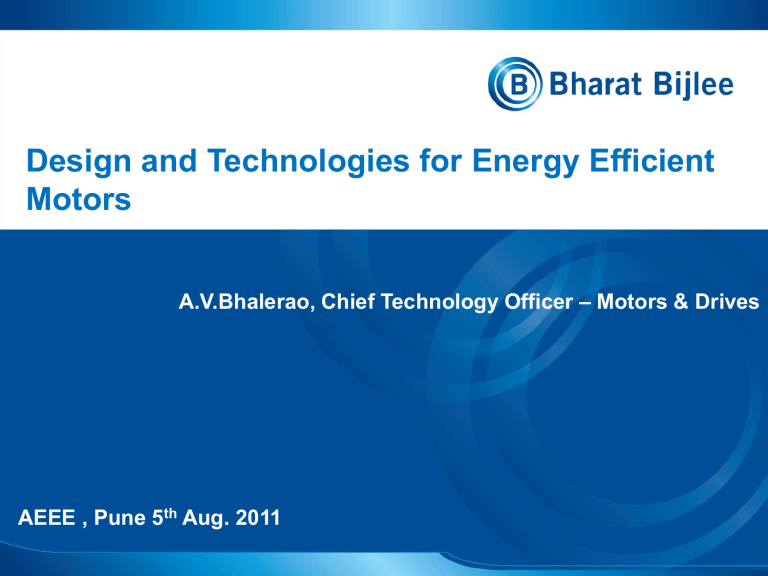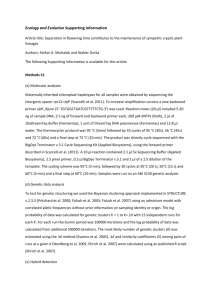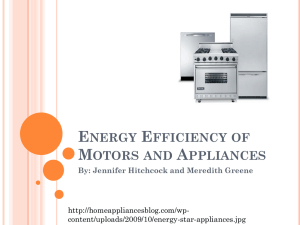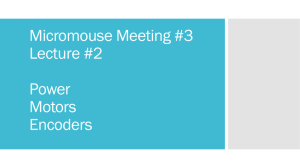Bharat Bijlee Bhalerao

Design and Technologies for Energy Efficient
Motors
A.V.Bhalerao, Chief Technology Officer – Motors & Drives
AEEE , Pune 5 th Aug. 2011
Why have high efficiency motors
Save energy – this is a national priority
Reduce operating cost
Reduce harmful greenhouse gas emissions
Energy Efficient Motors A National Priority
70 % of all electrical energy consumed in India is used for driving electric motors
55 % of which is consumed by industrial motors
Consumption of Electricity by Sector
OTHERS; 30%
AGRICULTURE,
31%
A saving of 1 or 2 % by industry can save 500 MW
INDUSTRY; 39%
Initial Cost of an 11 kW motor is only 3.9% in the first year of operation
Purchase Cost (Rs), 24862/-, 3.9%
Annual Energy Cost (Rs) 6,42,700/-, 96.1%
Assumptions: Efficiency Eff2 : 89.0% (BBL)
Energy cost: Rs 6.5 per kWH
Working: 8000 hrs pa
Life Cycle Cost of a Motor
In one year, a motor consumes energy equivalent to 10 to 25 times its purchase price
Many consumers in India especially OEMs purchase cheap motors having low efficiency values
National Standard for Energy Efficient Motors
IS 12615: 2004 (First Revision)
Energy Efficient Induction Motors — Three Phase Squirrel Cage
IS 12615 covers Energy Efficient motors from 0.37kW to 160kW (up to Fr. 315L)
IS 12615 specifies two efficiency levels : - eff2 and eff1
IS 12615: 2004 (Second Revision) ( Under printing now)
The new revision is in line with IEC 60034-
30 ““Efficiency classes of single speed 3 phase cage induction motors” .
Defines efficiency classes IE1, IE2 and IE3.
Range covered now upto 375 kW
Testing as per IEC 60034-2-1
IE1 and IE2 : Slightly lower than eff2 and eff1 (to compensate for new testing method in which stray losses are higher)
Comparison of eff & IE classes
Output eff2 IE1 eff1 IE2
5.5kW
4P
85.7 84.7
89.2
88.2
IE3 IE4
89.9
91.3
11kW
4P
88.4
87.6
91.0
90.2
91.7
92.9
IS 12615: 2004 (First revision) - superior to existing Std.
IS 8789
To be considered as energy efficient, a motor must conform to one of the following efficiency levels specified in IS 12615:
Improved Efficiency (eff2)
High Efficiency (eff1)
eff1 efficiency levels are higher than those of eff2
Both eff1 & eff2 are higher than the nominal values specified in IS 8789: 1996
Why does revised IS 12615 specify three efficiency levels?
User has the option to go for IE2 or IE3 motor and save energy but at higher initial cost. It is strongly recommended to go for IE2 motor when utilization is high
The standard is hence user friendly since it has provided three levels of efficiency.
This in line with other international standards like IEC.
Comparison of efficiencies of Standard & Energy
Efficient Motors
Output 4 Pole IS 8789
0.75 kW
1.5 kW
3.7 kW
11 kW
18.5kW
37 kW
75 kW
110 kW
160 kW
71.0%
76.0%
83.0%
85.5%
87.0%
88.5%
Not specified
Not specified
Not specified
Efficiency values are subject to tolerance as per IS325 eff2 as per
IS 12615
73.0%
78.5%
84.0%
88.4%
90.0%
92.0%
93.6%
94.4%
95.0% eff1 as per
IS 12615
82.5%
85.0%
88.3%
91.0%
92.2%
93.6%
94.7%
95.2%
95.8%
Why is the Energy Efficient motor more expensive?
eff1 motors are generally priced 5 - 15 % higher than eff2 motors
More laminations - longer core length and/or
High Grade (low loss) laminations
More Copper
Rs
How is efficiency improved?
Increase in Active material
Reduce Iron Loss Reduce Copper Loss
Reduce
Stator Cu Loss
Reduce
Rotor Cu Loss
Reduce
Flux Density
Increase
Copper Section
Stator slot area
Low Loss Magnetic matl.
Increase Reduce
Stator Yoke Rotor Dia
Increase
Rotor bar section
Increased
Starting current Speed
Reduced Starting Torque
Core length has to be increased to maintain starting torque
How is efficiency improved?
Cooling fan size:
Since losses are reduced in an EE motor, it requires less cooling air.
Hence fan size can be reduced, resulting in reduction of fan losses.
Special low loss bearings:
SKF have developed a new range of Energy Efficient (E2) bearings for energy savings. These can be used to reduce friction losses.
( Reduction of upto 30 % possible)
Energy Efficient Motors have a Flat Efficiency Vs Load
Characteristic
Motor rating is selected for max. load conditions and next preferred rating
Most motors operate on an average around 75% load
Efficiency is almost same from
60% to 100% load in a well designed EE motor
95
90
85
80
75
70
70
86
80
89
84
89
85.5
65
60 60
25% 50%
Load
75%
Motor As per IS 8789
100% eff2 Motor
eff2 motor gives savings over an IS 8789 motor
Purchase Price of 11kW/4P motor Rs
Efficiency
Energy consumption p.a. for 8000 Hrs @ Rs
6.5 per kWh
Energy Saving p.a. Rs
Additional purchase price Rs
IS 8789
22600
85.5%
6,69,000
26,300
2262 eff2
24862
89.0%
6,42,700
Pay Back Period of eff2 motor is 0.7 month for a 10% price increase over an IS 8789 motor
eff1 motor gives further savings over an eff2 motor
Purchase Price of 11kW/4P motor Rs
Efficiency
Energy consumption p.a. for 8000 Hrs @ Rs
6.5 per kWh
Energy Saving Rs
Additional purchase price Rs eff2
24862
89.0%
6,42,700
17563
3728 eff1
28590
91.5%
6,25,140
Pay Back Period of eff1 motor is 2.5 months for a 15% price increase over eff2 motor
Energy savings at partial loads
11kW-4 Pole BBL eff2 motor Vs eff1 motor.
Load
Working Hrs. p.a.
Eff of eff1 (BBL stock motor)
Eff of eff2 (BBL stock motor)
Energy saving p a @ Rs 6.5 per kWh
100%
3000
91.5%
89%
0.338
Rs. 6585
Total Energy saving per annum : Rs 14230
Additional Price of eff1 motor over eff2 motor : Rs 3728
Payback Period is 3.1 Months
75%
3000
91.5%
89%
0.338
Rs 4394
50%
2000
89.5%
86%
0.50
Rs. 3251
Energy Savings Ready Reckoner
Energy Savings Ready Reckoner for e ff1 Motors
You must enter blue cells
Motor Rating / Polarity 45 kW / 4P
Energy Cost: Rs / kWH 5
225M
225M
% of load
Working Hrs pa.
Efficiency of eff1
0% load
50% load
75% load
2000 3000
91.9
93.9
Efficiency of eff2 eff2 motor: kWH pa.
0 eff1 motor: kWH pa.
0
Energy Saving: Rs. pa.
0
91
2421
93.2
100% load
3000
93.9
Total
8000
49451 108637 144850 302938
48966 107827 143770 300564
4049
93.2
5399 11870
Pay Back Period 7.6
months eff2 eff1
Purchase Price of
Motor in Rs
83149
75592
7557
Energy Efficient Motors- Speed and Starting current
Due to reduced rotor losses, speed is higher.(5-15rpm)
The driven equipment ( fan / pump ) should be designed accordingly
Due to reduced rotor and stator resistance, starting current is higher. This can go to 700 % in eff1 motors.
When used with a VVVF drive, this does not matter as the drive takes care.
In other cases, this should be taken care during system design.
Bharat Bijlee Range of eff1 & eff2 motors.
eff2 and eff1 motors are offered by Bharat Bijlee ex-stock
Bharat Bijlee also offers a complete range of eff1 customised motors orders with a lead time of 8 weeks
Bharat Bijlee does not manufacture motors of efficiency class less than eff2
Energy Efficient Motors for Hazardous Areas
BBL has standard catalogued energy efficient series motors for use in hazardous areas
Type MD – Flameproof Ex(d) eff2
Type MJ – Flameproof Ex(d) eff1
Type ME
– Increased Safety Ex(e) eff2
Type MI – Increased Safety Ex(e) eff1
Type MN
– Non Sparking Ex(n) eff2
Type MS – Non Sparking Ex(n) eff1
Energy Efficient Motors- Flameproof, Increased Safety &
Non sparking motors
eff1 motors can also be offered against customer requirement with a lead time of
8 to 10 weeks
In a few eff1 outputs, next higher frame size is required
Nameplates - marking of Efficiency
BB High Efficiency Motor
Bharat Bijlee EE motors are clearly labeled “Eff 1 or Eff2”
When Should I Consider an eff1 motor
More than 4000 hours of operation per annum
New installations, typically HVAC systems and process industries
Replace with eff1 instead of rewinding old motors
rewinding increases iron and stray losses
As part of a preventive maintenance or energy conservation plan
Intermittent duty applications….?
Intermittent duty motors are typically used in crane, hoist, valve actuators and other applications with frequent starts
In these applications, motors are designed for low starting losses rather than low running losses
For intermittent duty applications EE motors are not the best choice
Problems in field testing
Efficiency measurement at site is unreliable.
One needs to decouple the load in order to measure no load losses
Variable voltage supply required in order to maintain rated voltage
We recommend measurement of kWh using a energy meter and compare two motors
Measurement of current is not a reliable indicator. Current is not directly proportional to input power because power factor varies with load and voltage
Successful case studies
Industry : Textiles : Applications : Yarn Twisters, Spinning frame
Existing mills in Surat had,
1) Existing old motors, rewound several times
2) Low load factors
3) Long hours if operation
Approach : 1) Extensive seminars, both in house and in common forums
2) Discussions with users at several levels and working out of potential payback and power savings
3) Sample trials and actual demonstration of energy savings.
4) Payback 6 to 12 months for new motors
5) Client placed orders for about 200 eff1 motors and installed.
6) Other mills in same area are changing over to eff1.
Successful case studies
Industry : Paper : Century Pulp and Paper, Venkraft Papers
: HVAC : Blue Star, Voltas
: Fertilizer : Deepak Fertilizers : Hazardous area Ex(d) and Ex(e) eff1 motors
: Pharmaceuticals : Jubilant Organosys :( Ex(d) and Ex(e) eff1 motors)
: Chemical : Grasim Industries
Approach: 1) Extensive seminars, both in house and in common forums
2) Seminars and discussions with consultants. Showing how eff1 can be achieved even in hazardous area motors.
3) Jointly working out of correct power ratings of various applications.
4) Calculations of power savings .
5) Clients witnessing actual type tests at our works and seeing the efficiencies being achieved.
6) Customer support whenever required.
Testimonial from Grasim Industries – Chemical Division
TO WHOMSOEVER IT MAY CONCERN
We are using Bharat Bijlee make energy efficient motors ranging from 5HP to 100 HP since last 2 years and their performance is satisfactory. We have achieved substantial savings by way of energy conservation.
For GRASIM CHEMICAL DIVISION
KBV PRASANNARAO
GENERAL MANAGER (ELECT. & INST)
Selective list of our eff1 Customers
TEFC Motors:
Abhishek Industries
A.P.Solvex Ltd
B.A.R.C.
DSM Anti-Infective (I) Ltd.
Finolex Industries
Garden Silk Mills
Grasim Industries
G.V.D. Textiles
Hindustan Zinc
Hightemp Furnace Ltd.
Indian Steel Co Ltd.
JCB (I) Ltd
Koramandala Fertilizers
KSB Pumps
VVF
Rathi Group
Sandoz
Ultratech Cement Ltd.
Power Build Ltd.
IFFCO
Century Rayon
Thermax Ltd.
Mather and Platt
Kanoria Chemicals
Essar Steel
Gujarat Narmada Valley
GSFC
Nirma Ltd.
Taj Group of Hotels
Purvi Pumps
Aditya BIirla Nuvo Ltd.
Savita Chemicals Ltd.
Kilburn Engg. Ltd.
Sutlej Textiles
Metso Minerals (India)
Yuken India Ltd.
ELGI Equipments Ltd.
Divi’s Laboratories Ltd
New Allenbury Works
Varat Pumps & M/cs
Shanti Gears Ltd.
Rank Cranes
Pashupati Spinning
Kirloskar Ebara
Selective list of our eff1 Customers
Hazardous Area Motors (Flameproof and Increased safety) :
DCW Ltd.
Divis Lab.
DSM Anti-Infective (I) Ltd.
Ingersoll Rand (I) Ltd.
Ranbaxy Industries.
Aarti Industries
Hikal Ltd
GMM Pfaudler Ltd.
Kilburn Engg. Ltd.
Themax Ltd.
VVF Ltd
Sandoz Pvt.Ltd.
Kanoria Chemicals & Industries
Dresser-Rand India Pvt Ltd.
Gujarat Narmada Valley
KSB Pumps
Milton Roy India
Growth in Eff1 motors business
Year
2007 - 08
2008 - 09
2009 -10
2010 -11
% Eff1 to std kW
4.6
Value
4.3
14
21
25.3
12.5
18
21
Bharat Bijlee manufactures the complete range of Energy Efficient motors conforming to eff1 of IS 12615. These are all catalogued ratings.
Bharat Bijlee maintains stocks of popular ratings of eff1 motors
Customer awareness and interest.
Summary and Conclusions
There exists a national standard IS 12615: 2004
(Revision 1) for energy efficient three phase induction motors from 0.37kW to 160 kW.
(Revision 2) will bring it in line with IEC stds and extends range to 375 kW
Energy savings are more at partial loads because Energy Efficient motors have a
Flat Efficiency Vs. Load Characteristic
Payback period of eff2 motor over IS-8789 motor is approx 1500 working hrs.
Payback period of eff1 motor over eff2 motor is approx 2500 working hrs.
Customers realize that they actually save huge amount in power bills.
Successful introduction initially requires close interaction with customer.
Use of Energy efficient motors is on the rise.









